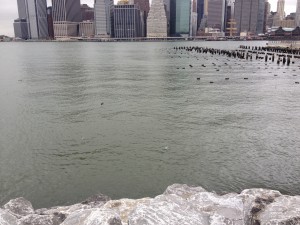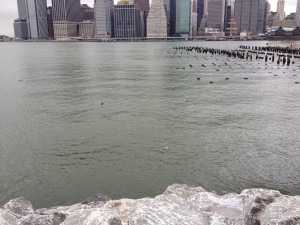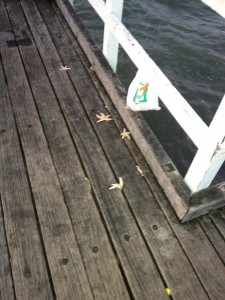Plastics Make it… Problematic

The American Chemistry Council sponsors an initiative “Plastics Make it Possible.” While there is no debating the fact that plastics have completely transformed modern life, from lifesaving medical devices to cellular phones to food storage to sports equipment, to well, you name it; we owe a lot to this accidental creation of Hans von Pechmann: polyethylene.

What is debatable, and I believe warrants a global discussion, is how we use and dispose of plastic. Herein lies the conundrum that is plastic. It’s everywhere. It’s in a lot of places it shouldn’t be – deposited on sidewalks, stuck in trees, bundled in landfills. It lies along roadsides, overflows trash bins and is adrift in fields. Ultimately, plastic winds up in storm drains, streams, rivers, the ocean; wreaking havoc on wildlife and aquatic life.
The Great Pacific Garbage Patch, I’ve wrote about it here before. This plastic soup, twice the size of Texas lies between 135°W to 155°W and 35°N to 42°N, give or take. Captain Charles Moore caught his first glimpse of the garbage patch in 1997, returning home from a sailing competition. It has increased in size 100 fold in 40 years and yet we do nothing about it. The blob continues to multiply – it stretches out its sticky mitts reaching for fishing line, cigarette butts, toothbrushes, plastic bottles and butane lighters. But the problem exacerbates as it traps marine life, including fish shrimp, seagulls, albatross and turtles.
Algalita Marine Research Foundation has performed more research and studies on the Great Pacific Garbage Patch than anyone. Captain Moore and his highly distinguished research team have mapped it, sailed there, catalogued its contents and continue to monitor its status. What solutions do we have to rid the ocean of this hazardous waste site? Take a trawler, pick it up and haul it back to shore? If we can’t haul it back (perhaps it would break up further and disperse farther with travel), then send ships to carry back smaller sections. Could we scoop up “small” parcels at a time, lift it on board the ship and sail back to port where the material can be sifted, sorted and perhaps salvaged for re-use?

What could this drifting plastic be reused for? Could it be melted down and used as a building material to create affordable housing in low-income communities? (Assuming material proved safe with no leachate.) Could we transform it into the turf material that the soles of old running shoes are melted down into and then used to create running tracks, walking paths and playgrounds? Could we craft recycling bins out of it to help contain the problem in the first place? Flower pots, dog houses, clothespins, picture frames, more butane lighters and toothbrushes to replace those lost at sea…the possibilities could be endless. Why haven’t we done anything? Why hasn’t Sir Richard Branson gotten his golden fingers on this…Virgin Recycling, Mr. Branson? You’re helping us get to the moon; surely you can help us clean up the ocean. (As part of the Virgin Companies, the Virgin Earth Challenge (appears stagnant) and Virgin Green Fund (appears active) focus on global warming and renewable energy.)
Oh, it will cost money for a cleanup operation of this proportion. It may not be an apple to apple comparison, but the Deepwater Horizon oil disaster on the Gulf Coast is being cleaned up. Consider this:
Area of Deepwater Horizon Oil Spill: 2,500 to 68,000 sq mi (6,500 to 180,000 km²)
Area of Texas: 268,820 sq mi (696,241 km²)
Area of Great Pacific Garbage Patch: estimated to be twice the size of Hawaii, twice the size of Texas, or the size of the entire United States – 3.8 million sq mi. (9.8 km²). Apparently, the verdict appears to be that we just don’t know how big this floating island of flotsam is.
The components and precursors of the products that make up the patch stem from oil. It’s a spill; a plastic spill from the land to the ocean, does it not warrant cleanup? Is it because we cannot see the direct effects? Is it because we are not bombarded with images on the evening news of birds and seals covered in black tar, or because humans are not impacted by concerns of drinking water consumption or we don’t hear the dire pleas of the tourism industry, does it not warrant the same attention and solution? Maybe we need a 24/7 webcam…turned reality TV show…
If we cannot see the direct effects, know that indirect effects to humans do exist and the problem could worsen. Many of us enjoy seafood, but 85% of the world population relies on fish for their protein intake. Plastic isn’t biodegradable. The fishing lures and toothbrushes and water bottles floating on the open sea go through a process called photodegradation—meaning the product breaks down into smaller and smaller toxic particles that end up entering the food chain when animals ‘accidentally’ ingest them. Jellyfish eat these toxin-containing pieces, which are then eaten by larger fish. Humans consume these larger fish, which results in ingestion of toxic chemicals. Research has shown that plastic has changed the functioning of some albatross species’ reproductive systems. Marine birds and animals that consume these inert plastics pass the particles on when feeding their young. The cycle continues.

Starting with Small Solutions
Some cities in America have implemented plastic bag bans while others charge for a plastic bag. Just a handful of companies are producing biodegradable bags, from corn for instance. These bags will dissolve in between 4-12 weeks in a landfill. This could be a challenge for scientists to do a little better and develop the ultimate biodegradable bag, and be a real win-win for business and the environment. In the meantime, perhaps you can start to carry a cloth bag with you to market.
It’s clear some cities and towns have a shortage of recycling bins if trash cans are overflowing and plastic is rolling down the sidewalk. (But maybe they just don’t have the manpower to keep up with a problem as big as plastic.) A solid campaign of education programs in schools teaching youth proper ways to dispose of plastic might begin to turn the tide. Small changes can add up and make a big difference. And the biggest difference we must make is ridding the Pacific Ocean of the problem of plastic.
 Follow
Follow
Thank you Kelly for this great article.
I invented and patented a water tractor just for such a harvesting purpose. There’s money to be made and fun to be had harvesting this garbage. I can get no one with seed money to listen.